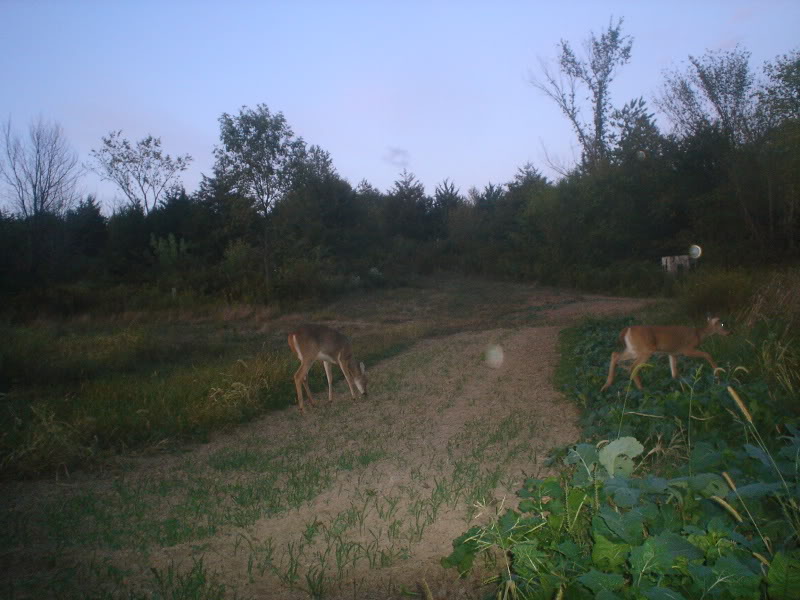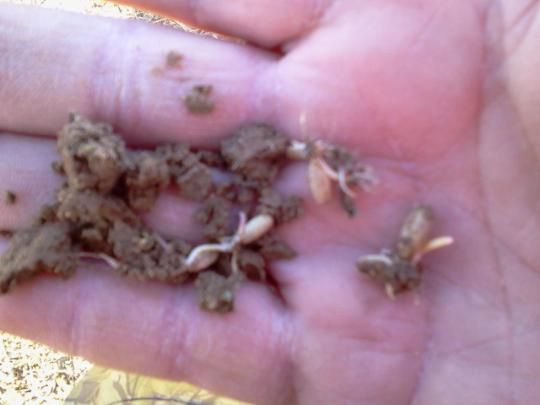November 24th, 2012
Late November update on the strip crop feeding areas....plenty of very cold weather with temps down as low as 15 but the rye and brassica strips are still green and very attractive to whitetails
Deer density is relevant to the quality of adjacent cover and crop usage is relevant to proximity of the feeding area to quality cover...this pic is from a farm I use to own and still manage. Thick timber and large stands of NWSG surrounding the feeding area = large numbers of deer which in turn = heavy grazing. 6 acres worth being ravaged.... no sign of frozen oats because they are gone!
5 acres being heavily grazed, relatively high deer density but adjacent cover is out of our control which is somewhat limiting. Note volunteer oats from the spring seeding of oats and crimson clover created a thicker then usual stand but now they are freezing out...perfect to leave a great mulch for the young clovers while the winter rye continues to feed deer.
Perhaps middle of the road feeding areas....holding up well but seeing plenty of grazing nonetheless
Note that the oats provided plenty of early fall forage while the slower growing winter rye got going, now the oats are freezing out, the rye remains to feed deer thru the winter into spring yet the planting rate is not so high as to cause it to suffocate the red clover planted with it.
Close ups of the rye mix...this being the very first planted around the 22nd of August...
This in the same field planted last about mid September...to late for radish or peas and both rye and oats have been heavily grazed. Look closely and you can see the hairy vetch seedlings added here....another fantastic green manure and nitrogen fixing legume that can do well on both sand and clay and is excellent to add with rye for building soils
The radish plants have been grazed off and the remaining foliage has frozen as it is not as cold hardy as the turnip and rape plants
Where the oats were thicker and got taller, some radish plants escaped grazing and are still green
It did however do it's job, providing a very succulent and attractive source of forage in the mix
Average length of radish roots planted in late August...this being an optimal length for great soil benefits. Unseen (because I pulled it rather then dug it up) are the lateral roots and the tap root extending deep into the subsoil. In 30-45 days radish plants can do a great deal to reduce soil compaction and and bring up subsoil nutrients...all while feeding your deer!
The winter peas are the candy in the mix and in every feeding area one is hard pressed to find any
The peas are not dead but most are eaten to the dirt
the combination of radish and peas in this mix helps keep deer from visiting nearby corn and soybean fields during harvest
The clovers look outstanding...and unfortunately the clover component is the most over looked crop in this mix
The mammoth, medium red clovers (any red clover is fine buy the least expensive you can) will provide spring and summer long grazing to keep whitetails coming to your feeding area. They will fix up to a 130#'s of N for the rotation to brassicas as well as adding 2 1/2 tons of outstanding biomass to your soils...all for a few bucks worth of seed....
All of that isn't worth a hoot if deer don't eat it...but whitetails are opportunistic feeders and will take advantage of any food sources closest to their bedding area provided it is safe and secure. While grazing is obvious in the previous pics...cams on the fields provide plenty of evidence of what's really going on....
Constant harassment by bucks in November causes does to feed at night and separates groups for awhile as the searching gives way to breeding in mid November but they visit the plots nonetheless
and where the does are...
the bucks will be prowling in November...
It's not the rye, it's not the turnips or clover...it's the combination of heavy, thick bedding cover surrounding hidden secluded feeding areas that lie adjacent to the bedding
Provide ALL the pieces of the habitat pie and you will reap the rewards of your efforts
Bucks have to eat too...and while they may stop only for a bite in November...they'll spend a lot more time here in December and January
Remember that assuming whitetails have access to normal browse there is nothing we can feed them that will have any significant affect on antler growth. Each animal is an individual with the genetics to reach only a given size and that potential can only be reached with....age...
Building a complete habitat program gives us at least some chance of holding whitetails on our property...
and allowing them to mature
It is up to us to make a choice to let them walk
and it is also up to each of us to completely understand whitetail habitat, the limitations and realism's of both habitat and whitetails and not allow hype and myth's to cloud our judgement
Cereal grains will not grow giant deer, neither will turnips, corn, soybeans, clovers or a boat load of minerals so utilize ALL the habitat improvements and management tactics together to reach your goals. Perhaps you wish only to take your family hunting or it may to harvest a mature animal regardless of score, but your goals are within reach and the following crop mixes are just one small yet effective step towards a complete habitat program.....
Plant ALL in one plot in strips or blocks
Alice, Kopu II, Durana (or comparable) white clover 10% of plot, sow at 6#'s per acre with the rye combination in the fall or in the spring with oats and berseem clover. Correct Ph and P&K with soil tests
Brassicas in 45% of plot
Purple Top Turnips 3#
Dwarf Essex Rape 2#
GroundHog Forage radish 5#
Plant in mid to late July in most Midwest states, or 60-90 days before your first killing frost, Use 200#'s of 46-0-0 urea and 400#'s of 6-28-28 per acre. Follow the dead brassicas with oats and berseem or crimson clover in mid spring at 60#'s oats and 12-15#'s berseem clover and/or 50#'s of chickling vetch)
Cereal Grain combo in 45% of plot
Winter rye 50-80#'s per acre (56#'s = a bushel)
Spring oats 80-120#'s per acre (32#'s = a bushel)
Frostmaster Winter Peas or 4010/6040 Forage peas 20-80#'s per acre
Red Clover 8-12#'s per acre or white clover at 6#'s per acre (or 20-40 pounds hairy vetch and 20-30#'s crimson clover on sandy soils)
Groundhog Forage Radish 5#'s per acre
Plant in late August to early September, if following well fertilized brassicas use 100 - 200#'s of urea, if starting a new plot add 400#'s of 6-28-28
Rotate the brassicas and rye combo each year
















































































